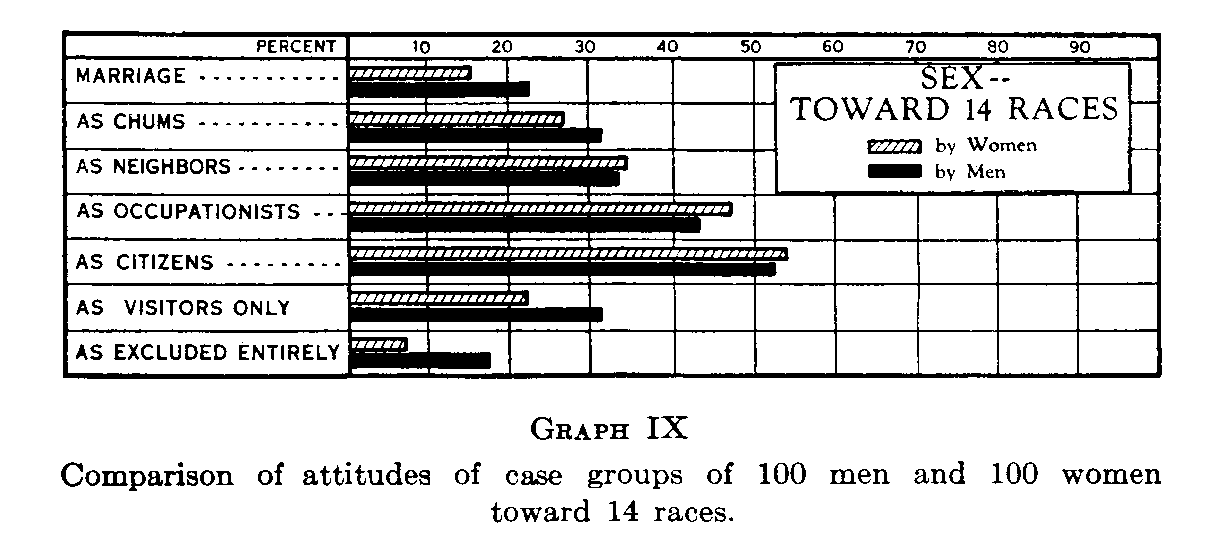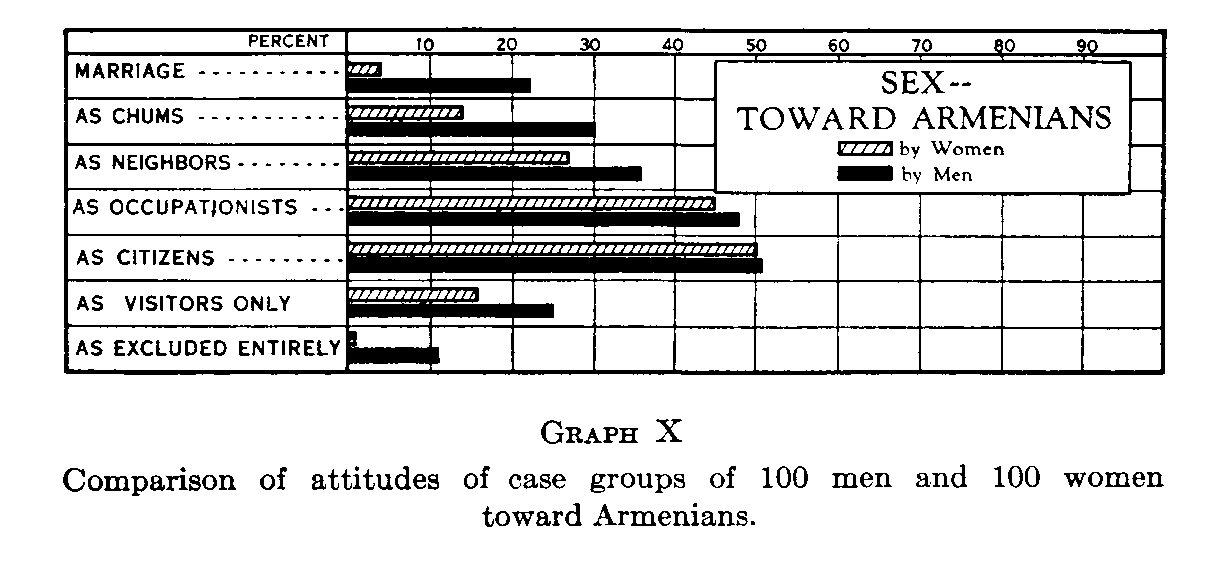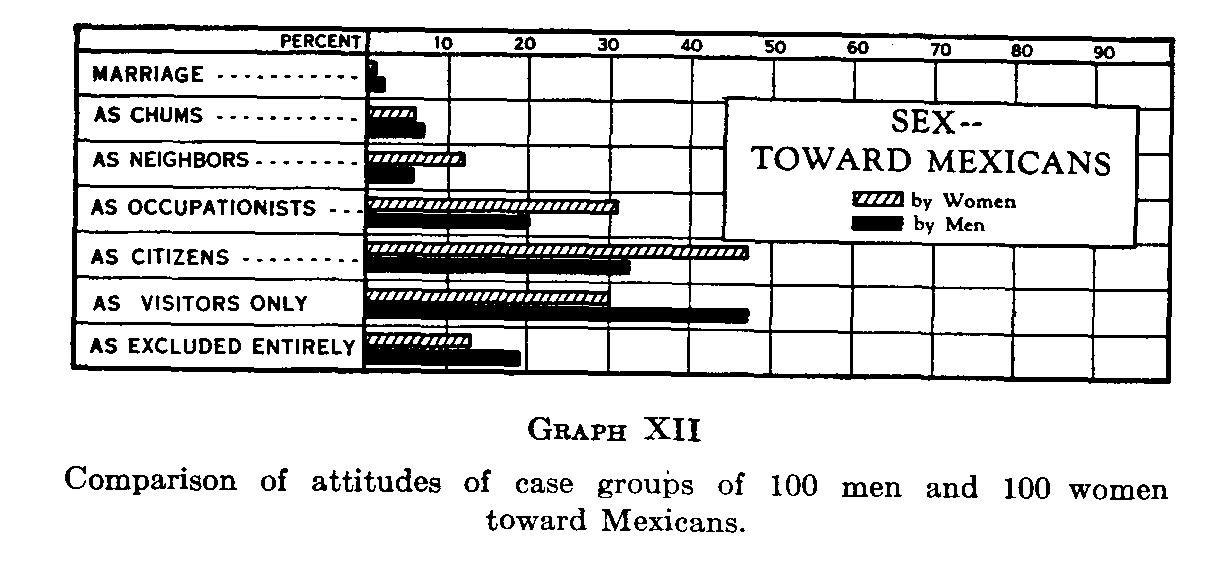Immigration and Race Attitudes
Chapter 14: Sex Distinctions
Emory S. Bogardus
Table of Contents | Next | Previous
In what ways are men distinguished from women in their racial attitudes? Sex contrasts in racial attitudes are many. In the first place, racial relations data show that in the main women are more reserved than men in making racial contacts. They seem to give more personal attention than do men to racial distinctions. A member of an immigrant race is viewed by a woman as a different person; by a man, as a laborer, a possible competitor in business, or a new "prospect." Women are more affected than men by unpleasant sense stimuli, and hence develop antipathies. Both men and women react against immigrants who become social or economic competitors, and thus develop prejudices.
As a rule, women are somewhat slower than men in entering into racial intermarriage. A leading variation from the general rule is the woman who out of sympathy befriends immigrant peoples. But in befriending the men of immigrant races, a woman often discovers that many such men, especially if they be unmarried, are prone to think in terms of matrimony. This realization often comes to American women as a shock. Women religious workers, social workers, night-school teachers, and others report many interesting experiences. Occasionally, a racial intermarriage results.
When the definite suggestion is made to American women that they marry men of other races, they react more quickly against the idea and in a larger percentage of cases than do men to marrying women of other races and religions. The risk is considered greater; mistakes arc more serious.
( 185) The wish for security is aroused more definitely, and ostracism is more likely.
In large cities, as contrasted with smaller communities, the situation is changing, and racial intermarriage of women with men of other races is apparently increasing. In examining the statistical data regarding marriages in New York City (1908-1912), Dr. Julius Drachsler concludes: " The ratio of intermarriage for women is slightly lower than that for men." He accounts for this result on the ground of " the relatively greater mobility and aggressiveness of the man, and the greater conservatism of the women." [1] If Dr. Drachsler's data had come from rural districts in the United States or from the smaller cities and towns, " the greater conservatism of women (because of stronger conventions and less mental mobility) would be more evident.General Racial Reactions of Men and Women. — A tangible method is experimentally possible for comparing the racial attitudes of the two sexes. Graphs IX-XIII are constructed from the recorded racial attitudes of two case groups of one hundred native American men and of one hundred native American women, representing the first two hundred out of a total of 1725. The members of both groups reside in the same regions of the United States, they possess similar degrees of education, they represent the same age-levels, they possess similar race ancestries and religious attitudes. Each group is the first hundred taken from their respective sex classifications.
When the racial attitudes of these men and women toward fourteen selected races [2] are studied, the degree to which women are more reserved in their reactions regarding marriage and also in the choice of chums is indicated (see columns 1 and 2 in Graphs IX, X, XII, and XIII. Graph
( 186) XI is an exception that will be discussed presently.) Women, however, are somewhat more friendly than men in the larger group relationships of life (columns 3, 4, 5, Graph IX) ; they are less likely to relegate foreigners to the status of " visitors only," and to wish to exclude for-

-eigners entirely (see columns 6 and 7). Women as a class, therefore, would seem to be somewhat more pronounced than men in certain of their race attitudes. The total

number of reactions to immigrant races by women is less than the number by men. The explanation is that women have less opportunity than men to make racial contacts. The differences in opportunity and in experience would account for a part of the difference in race attitudes.
( 187)
Specific Racial Reactions of Men and Women.—If the reactions of men and women to particular races be considered, interesting variations may be noted. Toward Armenians the women are decidedly more reserved (Graph X, columns 1, 2, and 3) than are the men, and at the same time less antagonistic where antipathy would most likely be revealed (columns 6 and 7). They report a greater reluctance to marry or to chum with Armenians than do men, but do not reveal so vigorous an antipathy.
The reactions toward the Chinese (Graph XI) show an abnormal tendency on the part of the American men:

namely, an unusually low degree of friendliness (columns 1 to 5 inclusive) and marked antagonism (columns 6 and 7). The women are more friendly than the men, chiefly on the basis of sympathizing with a race without high status. There are few matrimonial advances on the part of the Chinese men, unlike the attitudes of the men of some other races; hence the friendliness of American women operates unhindered.
In regard to Mexicans (Graph XII) the American women are more willing to grant them admission to occupational and citizenship status than are men, and less pronounced in debarring the Mexicans from residence in this country. On the whole, the women take a larger and more wholesome
( 188) view. The attitudes are somewhat different toward Russian Jews. The women hold back more than men in their friendly attitudes (columns 1 to 5 inclusive). On the other hand, they are not so pronounced in the "exclusion" attitude.

On the whole, therefore, the women under consideration are more reserved than men in their racial attitudes involving marriage and chums, and more friendly in the

larger group aspects of racial reactions. This latter point is also supported by a lesser tendency on the part of women than of men to exclude immigrant races.
In the further consideration of differences in sex reactions
( 189) to race, it should also be noted that men's reactions to the men of immigrant races is different from their reactions to the women of those races. " Differences " in the men of immigrant races produce aversive effects on American men, while " differences " in the women of other races are likely to be attractive, although distinctions in culture levels are important. These situations are paralleled in reverse form in the reactions of American women. They view foreign women of culture levels similar to their own somewhat competitively and hence with prejudice, but foreign men of the same culture level as themselves are often attractive, if not " captivating," on occasion.
106. As a man I am frank to say that my feelings toward Spanish women are kindlier than toward Spanish men. The latter seem to me to be smart Alecks, and always playing up to women. To be sure they are daring at times, but because their women folks want them to be that way. Nearly all Spanish men that I know are fine dancers, which after all is a mark of a lady's man. In company I cannot begin to do the " gallant " things that they do. Beside them at a party I seem stupid. But toward Spanish women, I think differently. I'm not sure that I'd want to marry one, but they do captivate me. They have certain sex charms that are hard to get away from. I like to watch them dance, for they are so bodily supple. No, I don't feel the same toward Mexican women, but the ones that I know are not educated and are pretty plain. They aren't in my " set," that's all.[3]
107. If you had known the nice French men that I have, you would rave about them too. I'm thinking of one right now who knows how to treat a woman right. He is so thoughtful, but not like American men, who are so studied and stiff in everything they do. He is just naturally nice, no effort, knows just what to do for you, before you even think of your own needs. I admire the Frenchman's eyes; they are so sharp and black and flashing. The Frenchman is witty, too. I would be willing to marry one, but for one thing. I would positively draw the line on going over there and living with French women. They don't do anything except dress and dress, and seek the attention of men. I have never seen such a superficial lot as were at R.'s house in Paris lest summer
( 190)
They did nothing but talk about men they had danced with. It was positively disgusting. It makes me sick to think about it.[4]
When changes in racial attitudes of the two sexes are considered, other distinctions appear. Table X gives the races toward which both sex groups, in the case studies already described, have experienced the greatest increases in race antipathy during the past five to ten years.
| Reported by 100 American men toward | Reported by 100 American women toward | |||
|---|---|---|---|---|
| Japanese | 18 | Chinese | 18 | |
| Chinese | 16 | Japanese | 16 | |
| Italians | 16 | Germans | 15 | |
| Russians | 15 | Negroes | 15 | |
| Turks | 15 | Turks | 14 | |
| Mexicans | 13 | Jews, German | 11 | |
| French | 11 | Jews, Russian | 11 | |
| Jews, Russian | 11 | Mexicans | 10 | |
| Jews, German | 10 | Greeks | 6 | |
| Negroes | 10 | Russians | 6 | |
| Germans | 8 | Filipinos | 5 | |
| Hindus | 8 | Hindus | 5 | |
| 15 other races | 32 | 12 other races | 26 | |
| Total | 183 | Total | 138 | |
The similarities in these lists are striking. The French and Italians alone are relatively high in the men's list, but do not appear in the women's column. All races toward whom women have grown more antipathetic, however, appear in the men's list. Increases in antipathy are expressed by the men toward 27 races (out of a possible 40) and by the women toward 23 races. A total of 183 adverse changes are reported by the men as compared with a total of 138 adverse changes by the women. A somewhat wider range of direct daily contacts on the part of men accounts for this difference, as indicated by the case-study materials.
(191)
In the consideration of increases in racial friendliness, it will be seen from Table XI that there are marked variations in the men's and the women's reactions. Six races in the men's group do not appear in the women's list, while eight in the latter list do not appear in the men's column. At any rate there is greater variation than in the men's and women's lists of increases in racial antipathy. All told, the men report increasing friendliness toward 31 races; the women, toward 29 — a small increase in the numbers of races as compared with the numbers toward which both sexes reported increases in race antipathy.
| Reported by 100 American men toward | Reported by 100 American women toward | |||
|---|---|---|---|---|
| Germans | 21 | Japanese | 25 | |
| Japanese | 13 | Negroes | 18 | |
| Swedish | 11 | Jews, German | 17 | |
| Chinese | 10 | Chinese | 16 | |
| French | 10 | Jews, Russian | 13 | |
| Italian | 10 | Indians (American) | 11 | |
| Spanish | 10 | Italians | 10 | |
| Filipinos | 8 | Armenians | 9 | |
| Russians | 8 | Mexicans | 9 | |
| English | 7 | Canadians | 8 | |
| Czecho-Sovaks | 6 | Norwegians | 8 | |
| Indians (American) | 6 | Swedish | 8 | |
| 19 other races | 54 | 17 other races | 44 | |
| Total | 174 | Total | 196 | |
The men cite 174 friendly changes; the women, 196a difference in favor of the women. This fact correlates well with the fact that these same men and women reported totals of 183 and 138, respectively, of increases in antipathy. These reports for the 200 persons in question, as judged by research interview data, may be interpreted in two ways: (1) that the women have had a smaller number of contacts With immigrant races than the men have had and (2) that
(192) the women have by nature a more social nature than men possess.
Taken altogether, the data indicate that women react more sympathetically toward immigrants than do men, that they are less favorable toward intermarriage, that women are more subject to adverse sense impressions of immigrants than are men, that women show more antipathy and less prejudice than do men, that women are more favorably responsive to immigrant men of their own or of a higher culture level and less favorably responsive to immigrant women of their own or of a higher culture level than are men.
PROJECTS
1. Interview a man and a woman of your acquaintance concerning their experiences regarding two or three specific races, and write up the two descriptions.
2. Compare in detail the differences involved when a man and woman each marries " out of his or her race."
3. Study the differences in attitudes toward racial intermarriage on the part of women in rural communities and of women in two or more different areas in a city of size.
4. Analyze the relations between the differences in race attitudes of men and women and their differences in culture (including the differences in each sex as subject to social controls, such as conventions).
5. Analyze the differences in the reactions and experiences of any man (or any woman) with reference to the two sexes of a foreign race.
SEX DISTINCTIONS
ABBOTT, GRACE, The Immigrant and the Community, Chap. III. Century, 1917.
HASKIN, FREDERICK, The Immigrant, Chap. XIX. Revell, 1913.
JOHNSON, CHARLES W., An Autobiography of an Ex-Colored Man, pp. 197-210. Knopf, 1927.
KAWAII, Y., " The Japanese Family," Jour. of Applied Sociology, Vol. VII, pp. 19-22.
LIU, CHIANG, " Chinese versus American Ideas Concerning the Family," Jour.
of Applied Sociology, Vol. X, pp. 41-45.
STEINER, J. F., The Japanese Invasion, Chap. IX. McClurg, 1917.